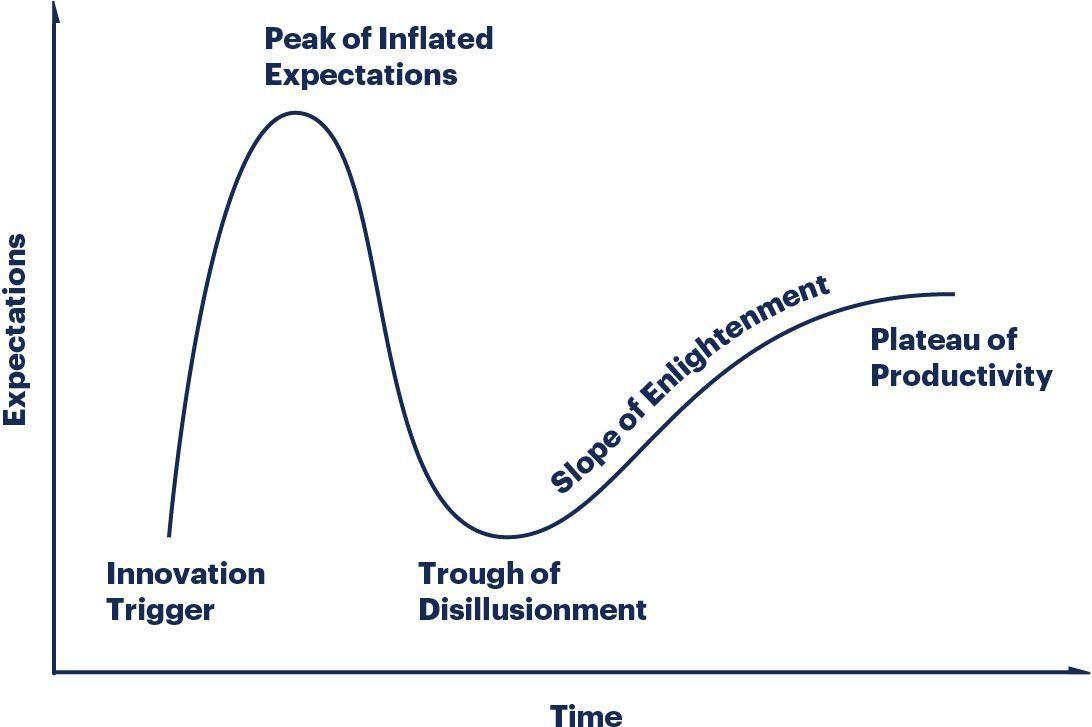
The opportunities and prospects for agile transformation are now widely discussed, attracting audiences from IT analysts to CxO-level managers. There are several Western (so far) schools known to achieve the so-called Enterprise Agility - it's really interesting and even fashionable. And like any hype according to the Gartner methodology, it feels like this direction is steadily moving towards the "peak of high expectations", after which the "abyss of disappointments" and only then a stable "plateau of productivity" awaits.
This is how it looks in general:

Let's try to summarize the preliminary results of such a transformation based on the experience of two completely different companies, the largest representatives of their industry, who were among the first in the Russian market to set foot on the path of full-scale agile transformation. Directly leading certain areas as a business architect, being responsible for structuring changes and developing a target organization model, I came to very pragmatic and not quite expected conclusions, which I will briefly share in this article.
So, let's imagine that experienced leaders of a certain large company are concerned about heightened expectations of shareholders, increased competition, redistribution of proceeds in favor of digital channels and the related challenges. As always, they are looking for ways to increase productivity, strengthen the brand's presence in the market and simply not lose the more discerning customers in the turbulence. Business bestsellers have been read, many hours of consultation have been spent, a decision is made to follow the current trend and start (or accelerate) the transformation of the management model. Someone says it's time to call the “big four”, which will explain everything, someone suggests implementing Scrum of Scrum or making a large general Kanban board ...
The first thing to start with
- a clear understanding of the goal for the sake of which we need to change: what business model the company sees for itself in the future and why, for its implementation, one cannot do without restructuring the organizational structure to achieve a fundamentally different level of flexibility and awareness in decision-making. This is a strategic stage, as usual, among other things, characterized by assessing their position and competitors, choosing benchmarks for comparison and shaping future scenarios with an assessment of global advantages and potential risks.
Further it turns out
that the agile transformation of a large company, contrary to stereotypes, while following the spirit of the agile manifesto, has little to do with what is commonly called agile methodology. The flexibility of a mature organization does not begin with the selection of products, and even less with certain ceremonies, but first of all with a strategy for managing internal investments, as well as with very specific measures to develop a corporate culture.
The first is manifested through the ability to delegate decision-making on investments in development, restructuring project portfolio management in favor of decentralizing budgets. At the same time, the ability to cascade strategic goals, set KPIs or OKRs, and combine top-down and bottom-up approaches is developing. There are interesting challenges, for example, for the CFO team - the need to democratize the financial and economic feasibility study and the subsequent assessment of the effectiveness of business initiatives. The essence of cascading is roughly shown in the figure:

The second is determined by an increase in the maturity of the company's management - this is critical, because, according to the studies carried out by the authors of the book Leader and the Tribe, the culture of the team will not be able to keep above the cultural level of its leader (personal observations are quite consistent with this). And in general, it is necessary to create conditions for the involvement of employees and motivation of the majority to value team achievements over personal ones - not only training is important here, but also a revision of the compensation system.
This is followed logically by the development of the company's architecture, starting with the key value streams, leading to a target organizational structure with a corresponding redistribution of powers and budgets, combined with the reform of collegial management at the strategic level.
Finally, all of the above must be put into practice, regardless of politics and conservatism, creating a safe environment for employees to transition.
And only at the next stage
we come to building a proper "cross-team" agile: focusing first on the launch, then on the interaction of specific product teams, following the recommendations of LeSS or SAFe (note that the new version 5.0 also covers most of the above), or creating their derivatives, as we did. Teams can be run in parallel, and often they make their own decisions about their readiness to use Scrum, for example. They are not always right, but this is definitely not the main problem. The main thing is not to lose sight of the fundamental foundations, without which transformation risks becoming a toy to attract talent.

Of course, you are on the right track if you implement a culture of continuous improvement, train teams, and certainly try to keep the client in focus. At the same time, the transformation cannot be carried out by a "cavalry swoop" and requires a clear economic justification and proper systematization. Otherwise, management falls into the trap of “agile visibility,” where energetic, positive rallies instill confidence in success and redefine the worldview (which is good), but do not contribute to a structured, data-driven approach to organizational reform and effective governance in the new environment.The ability to systematically and comprehensively carry out agile transformation of the company has recently begun to be called Structural Agility - this makes it possible to overcome inertia and build a truly flexible customer-oriented digital organization that is attractive to partners and investors, realizing the creative potential of its employees.
